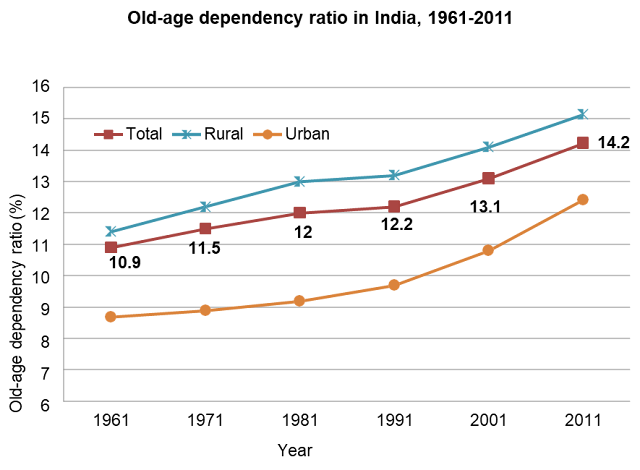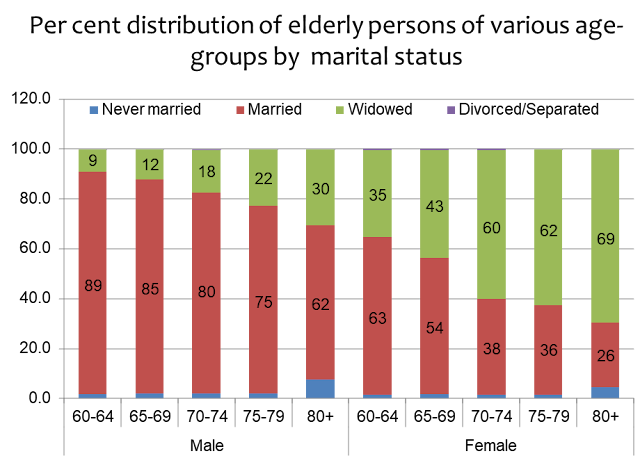Over the past few years, we have seen the remarkable growth in the number and proportion of old age persons worldwide. Such a rapid, large, and ubiquitous growth has never been seen in the history of civilization. The major reason behind this is that in the last few decades, the world’s population has continued on its remarkable transition path from a state of high birth and death rates to low birth and death rates coupled with improvement in health services & standard of living.
Aging Demography of India
· The world of the 21st century is reeling under the pressure of an ageing population.
· Proportion of elderly people in population of the countries across the world is increasing and same is true for India also.
· The growth in elderly population is due to the longevity of life achieved because of economic well-being, better medicines and medical facilities and reduction in fertility rates.
· The total population of the aged people in India was
o 104 million (As per census of 2011)
§ 53 million females and 51 million males.
o which is estimated to rise to
§ 177 million by the year 2025 (estimated)
§ 324 million by the year 2050(estimated)
· The percentage of elderly in our total population has risen from
o 5.58 in 1951 census to
o 7.5 in 2001 census and to
o 8.6 in 2011 census
§ For males it was marginally lower at 8.2%, while for females it was 9.0%.
§ As regards rural and urban areas, 71% in rural while 29 % in urban areas.
· India also recorded an improvement in life expectancy, which was
o 47 years in 1969, growing to
o 60 years in 1994 and
o 69 years in 2019.
· The old-age dependency ratio India as a whole climbed from
o 10.9% in 1961 to
o 13.1% in 2001 to
o 14.2% in 2011
o For females 14.9% and males 13.6% in 2011.
· In the age-group of 60-64 years,
o 76% persons were married while
o 22% were widowed
o Remaining 2% were either never married or divorced.
· The prevalence of heart diseases among elderly men and women was much higher in urban areas than in rural areas.
· Urinary problems were more common among aged men while more aged women reported to suffer from problem of joints.
· Population Census 2011 data reveal that Locomotor disability and visual disability are the most prevalent disabilities among elderly persons.
· Almost half of the elderly disabled population was reported to be suffering from these two types of disabilities.
· Population of working Elderly
o In rural areas, 66% of men and 28% of women, while
o In urban areas, 46% of men and about 11% of women
· More than 56% of elderly persons live with their spouse and 32% of aged persons live with their children.
· About 5% of elderly persons live alone while another 4% live with other relations and non-relations.
· With the westernization creeping in, the virtues and values, the emotional bonds, which existed in Indian traditional joint family system, have fallen off, slipped.
· A modern family no more remains the 'care-giver' like earlier days when it used to be 'caring' for its members from 'cradle to grave’.
· Career gaining supreme, the smaller, nuclear family has become mobile. Youngsters moving out are disinclined to carry their old parents along, which are physically and mentally declined and economically weak. They are left to live by themselves alone.
Geriatric health status in India
Figures from the previous studies conducted in India· 3.7 million suffer dementia
· 40 million suffer from poor vision
· 1.6 million annual stroke cases
· 1 in 3 suffer from arthritis
· 1 in 3 has hypertension
· 1 in 5 has diabetes
· 1 in 5 has auditory problems
· 1 in 4 suffer from depression
· 1 in 10 falls and sustains a fracture
· 1 in 3 bowel disorder
· Cancer is 10 times more common.
Impact of Demographic Transition
· The impact of the Demographic Transition can be described on health, economic and social scenario of a community or country.
· Impact on Health
o Increase in life span,
§ rapid increases in the elderly population.
§ the morbidities and disabilities in elderly have also increased.
§ This requires more health infrastructure to deal with the increasing number of morbidities and disabilities
§ This requires more workforce to deal with Manifestations of this special population
· Impact on Economy
o The demographic 'dependency ratio' also called the 'support ratio', is commonly used to assess the impact of age structure on economic wellbeing.
o Child dependency ratio, elderly dependency ratio and total dependency ratio are frequently employed.
o These ratios express the proportion of assumed
§ non-working population, [children (0-14) and/or elderly (60 years and plus)] and
§ working population, [adults (15-59)].
o There has been a steady increase in the elderly dependency ratio from
§ 10.9 in 1961 to
§ 14.2 in 2011.
o Aging of population becomes economically and socially more and more dependent with further increase in age.
o It indicates a gradual shift of the dependency burden from younger to older population over a time period.
· Impact on Social Outcomes
o Incidence of widowhood is become higher
§ potentially that disturb physical and mental wellbeing of individuals, thus have an impact on health.
o Older adults’ income security
§ Increasing price of commodities - limited buying power.
§ difficulties in meeting their basic needs
§ A large majority of the elderly in India continue to work, till their health and physical abilities permit them.
§ As a result, they are likely to suffer from malnutrition, leading to depression and mental problems.
o Shift from independence to dependence
§ as a result of loss of income or loss of spouse or loss of physical mobility either single or in combination.
§ Dependency can occur in multiple domains (e.g., mental, physical, economic dependence, or a combination of these).
Need for Dedicated Health care for elderly
· Rising Population
· Degradation in family values
· Increase vulnerability to diseases
· Different approach and management
· Chronic, disabling, and multiple Health problems
· Decrease in physical ability / Economic inadequacy
References
1. Williams
P, Wold G. Basic geriatric nursing. 6th edition. St. Louis, Missouri: Elsevier;
2016. 382 p. 4-10
2. Situation
Analysis of The Elderly in India Central Statistics Office Ministry of
Statistics & Programme Implementation Government of India [Internet]. 2011.
Available from: http://mospi.nic.in/sites/default/files/publication_reports/elderly_in_india.pdf
3. Population
Aging in Developing Countries | Health Affairs [Internet]. Health Affairs. 2020
[cited 2020 Sep 20]. Available from: https://www.healthaffairs.org/doi/full/10.1377/hlthaff.19.3.204#:~:text=The%20world’s%20elderly%20population%20will,5.3%20percent%20to%209.3%20percent.
4. Ageing
in India. World Health Organization [Internet]. 2015 Oct 3 [cited 2020 Sep 20];
Available from: https://www.who.int/ageing/publications/india/en/
5. Population
Pyramids of the World from 1950 to 2100 [Internet]. PopulationPyramid.net. 2019
[cited 2020 Sep 20]. Available from: https://www.populationpyramid.net/india/2019/
6. Prabha
Adhikari. Geriatric health care in India - Unmet needs and the way forward.
Archives of Medicine and Health Sciences [Internet]. 2017 [cited 2020 Sep
20];5(1):112. Available from: http://www.amhsjournal.org/article.asp?issn=2321-4848;year=2017;volume=5;issue=1;spage=112;epage=114;aulast=Adhikari
7. Manifestations
of Demographic Transition. Egyankosh.ac.in [Internet]. 2017 [cited 2020 Sep
20]; Available from: http://egyankosh.ac.in/handle/123456789/33259









Finnaly i got that blog which is a m searching thanking for sharing. If you need any kind of more info of hospital furniture you can visit ot table manufacturers
ReplyDeleteAs a frequent web user, I gotta give you props for such captivating content. From language to style it's almost like we had the same vision. Change your life this year with our CELPIP FOR CANADIAN IMMIGRATION 2022. We have been very careful to make sure our CELPIP CERTIFICATE FOR SALE gives you the opportunities you have been looking for. I'll definitely bookmark this page to read this article moe times. Happy new year fellow readers. you can join our group of Database certificates experts @ TELEGRAM GROUP
ReplyDeleteNatural herbs have treated so many illnesses that drugs and injections can't treat. I've seen the great importance of natural herbs and the wonderful work they have done in people's lives. I read people's testimonies online on how they were treated of Herpes, HPV HIV/AIDS & STDs, Diabetics , Gonorrhea, Hepatitis, Stomach infections, Chronic pains. etc. by powerful natural herbal medicine, so I decided to contact the doctor because I know nature has the power to heal anything. I was diagnosed with Herpes for the past years but Dr Chike treated me with his natural herbs and I referred my aunt and her husband to him immediately because they were both suffering from herpes but to God be the glory, they were treated too believe it or not, but I am a living testimony. There is no harm trying powerful natural herbs. Contact Dr on Whats-App number . +233502715551. or you can also contact through his Facebook Page @ Dr Chike Herbal Remedy.
ReplyDelete